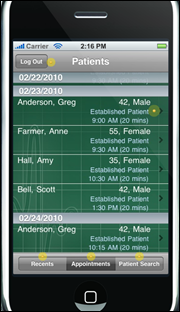News 5/18/10
Ulrich Medical Concepts, an EMR/PM vendor, earns a patent from the US Patent and Trademark Office. I must admit I had never heard of this company before, which was founded by Dr. Dennis Ulrich and is apparently installed in 12 states. In looking over the website and the press release, I can’t identify particularly unique about the product that warrants going the expense and hassle of getting a trademark, but what do I know.
I also have never heard of MTBC, a HIT company that just launched a “100% free medical billing software.” Since I’m convinced there aren’t too many free things worth having that are free (except the HIStalk blogs) I had to dig deeper. Turns out that providers must actually pay 4% of collections for the PM tools and 5% if they also want integration with a third-party EMR. That’s just silliness.
CMS selects Northrop Grumman to develop a National Level Repository to process HITECH payments to providers meeting Meaningful Use objectives. The order is valued at $34 million over one year with five and one –half year option periods.
Greenway Medical Technologies announces the availability of its PrimeMobile application for the iPhone, iPad, and iPod Touch. PrimeMobile works with Greenway’s PrimeSuite EHR.
Thanks to the reader who tipped me off about Vermont Information Technology Leaders (VITL) EHR demo week. VITL is a regional extension center, tasked with helping physicians adopt EHRs and earn meaningful use stimulus dollars. This week the organization is hosting one hour web-demos from athenahealth, Greenway, PRISM Regional, and Allscripts MyWay. At least three of those vendors are offering discounted pricing through VITL. The site offers a “selection process overview,” which seems pretty basic, though probably helpful to a truly novice buyer. I did notice that VITL says products “must” be certified, and that “for now, CCHIT is the certification body.” And, of course, that’s not true since CCHIT, nor any other agency, has been named a certifying body. I’m looking forward to hearing more details on what other RECs have cooking.
If you are a provider wanting to learn more about REC options and offerings, here’s a good overview. Keep in mind that each of the 60 RECs will have its own business model and pricing.
I must have missed this news from a couple months back. PBFOnline, who acquired the financially struggling MedcomSoft a year ago, merges under the single name of MedcomSoft. MedcomSoft also recently added a new director of sales and a director of operations.
Aprima Medical Software says its first quarter was strong and that the number of providers selecting Aprima has increased at a compound growth rate of more than 84% since 2004.
Adventist Healthcare (MD) chooses eClinicalWork’s EMR/PM system as an option for its employed and affiliated physicians. Adventist will also use eCW’s electronic healtheXchange for community records. I believe that Adventist also promotes Allscripts’ EHR.
Centegra Health System (IL) is partnering with Dell to launch a Centegra Physician Network, an HIE that provides EHR and PM systems. I think it’s safe to assume Dell will be supplying some hardware. Not so clear: which EMR vendors will be promoted.
If you can’t beat ‘em, join ‘em, perhaps? Medical transcription company MxSecure releases MxChart, a web-based EMR. Frankly I am surprised that more medical transcription company don’t offer EMRs to supplement (and preserve) their core business.
Kramer Healthcare Technologies deploys RQI Practice Management, a front-end verification tool for physician practices. Kramer already supports a similar inpatient product, RQi Registration Quality Improvement.
MGMA sends a letter to Secretary Sebelius, asking HHS to trim EDI costs and consider the administrative costs associated with processing claims when calculating medical loss ratios. More MGMA insights:
Health insurance administrative processes should be standardized to reflect the provisions included in the recently passed healthcare reform legislation and to free up needed resources for patient care. By including these onerous administrative costs in the calculation of health plan costs, plans would be pressured to more quickly standardize, simplify, and automate many of these interactions between plans and medical providers.
A former security guard in Texas pleads guilty to trying to shut down a Dallas medical clinic’s computer system, a day before he was suppose to quit. Supposedly the security guard (known as “Ghost Exodus”) was the leader of a hacker group called Electronic Tribulation Army and bragged about his exploits on the Internet before getting caught.
On a much more uplifting note, a pair of Orlando-area physicians leave their private practices to form Grace Medical Home, a facility serving working poor families and providing $20 office visits. Private donors, foundations, hospitals, and churches have all chipped in to help get the clinic operational. In addition, pharmaceutical companies are helping with the cost of expensive medications and local companies have donated lab equipment, painting services, cabinetry – and an EMR. Good stuff.










The article about Pediatric Associates in CA has a nugget with a potentially outsized impact: the implication that VFC vaccines…